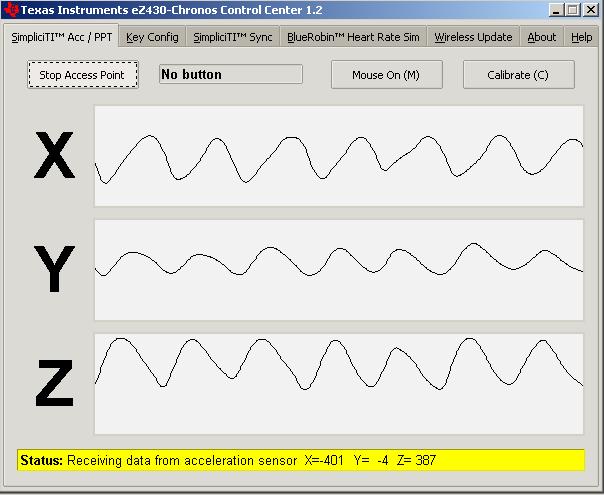SLAU292G November 2009 – July 2015
- Read This First
- 1eZ430-Chronos™ Overview
- 2Getting Started
-
3eZ430-Chronos Software
- 3.1 Overview
- 3.2
eZ430-Chronos Demo Software
- 3.2.1
Detailed Feature Overview - Modes Using the Top LCD Line
- 3.2.1.1 Time Mode
- 3.2.1.2 Alarm Mode
- 3.2.1.3 Temperature Mode
- 3.2.1.4 Altimeter Mode
- 3.2.1.5 Heart Rate Mode - RF Additional accessory or eZ430-Chronos Control Center heart rate simulation required.
- 3.2.1.6 Speed Mode - RF Additional accessory or eZ430-Chronos Control Center heart rate simulation required.
- 3.2.1.7 Tilt Mode
- 3.2.2
Detailed Feature Overview - Modes Using the Bottom LCD Line
- 3.2.2.1 Date Mode
- 3.2.2.2 Stopwatch Mode
- 3.2.2.3 Battery Voltage Mode
- 3.2.2.4 Acceleration Mode - RF
- 3.2.2.5 PowerPoint Mode - RF
- 3.2.2.6 Sync Mode - RF
- 3.2.2.7 Calorie/Distance Mode - RF Additional accessory or eZ430-Chronos Control Center heart rate simulation required.
- 3.2.2.8 Wireless Update - RF
- 3.2.1
Detailed Feature Overview - Modes Using the Top LCD Line
- 3.3 eZ430-Chronos Control Center PC Software
- 3.4 eZ430-Chronos Data Logger
- 3.5 Data Logger PC Software
- 3.6
eZ430-Chronos Software Projects
- 3.6.1 IDE Installation
- 3.6.2 eZ430-Chronos Software Flow
- 3.6.3 eZ430-Chronos Wireless Update Feature
- 3.6.4 eZ430-Chronos Firmware
- 3.6.5 eZ430-Chronos GUI Sources
-
4eZ430-Chronos Hardware
- 4.1 Programming the eZ430-Chronos Wrist Module: Disassembly and Assembly of the Housing
- 4.2 Functional Description of the eZ430-Chronos Wrist Module
- 4.3 Functional Description of the eZ430-Chronos RF Access Point
- 4.4 Functional Description of the eZ430-Chronos Debug Interface
- 4.5 Schematics, Layout, BOM, and LCD
- 4.6 Access Point Schematics, Layout, and BOM
- AFrequently Asked Questions
- BDetailed Hardware Driver Installation Guide
- Revision History
3.3.1.1 Acc Mode
In this mode, the Chronos module constantly transmits acceleration data to the PC. In addition, #, *, and UP button pushes are transferred. The Control Center software shows the 3D acceleration in graphs. Optionally, mouse control can be activated by clicking on Mouse On (M) or by typing M on the keyboard.
Once active, the PC mouse pointer can be controlled by tilting the Chronos module. Hold the Chronos module with its display facing up. The mouse pointer moves vertically (X-axis in Control Center) when tilting the wrist module forward or backward and move vertically (Y-axis in Control Center) when tilting it left or right. Mouse clicks are also possible–see the following description. Mouse control can be calibrated (to set a point of zero acceleration or no pointer movement) by selecting Calibration (C). It may be disabled by clicking Mouse Off (M) or by typing M on the PC keyboard.
- Left single click: * button
- Left double click: # button
- Right click: UP button
NOTE
Holding buttons (for example, to drag and drop) is not supported.
Turn the demo off by pushing the DOWN button on the eZ430-Chronos module and clicking "Stop Access Point" in the PC application.
 Figure 3-3 eZ430-Chronos Control Center With Acceleration Data
Figure 3-3 eZ430-Chronos Control Center With Acceleration Data